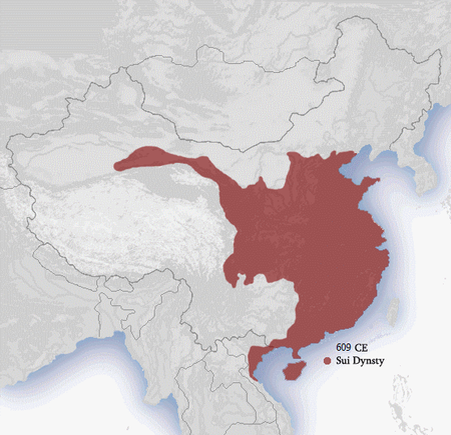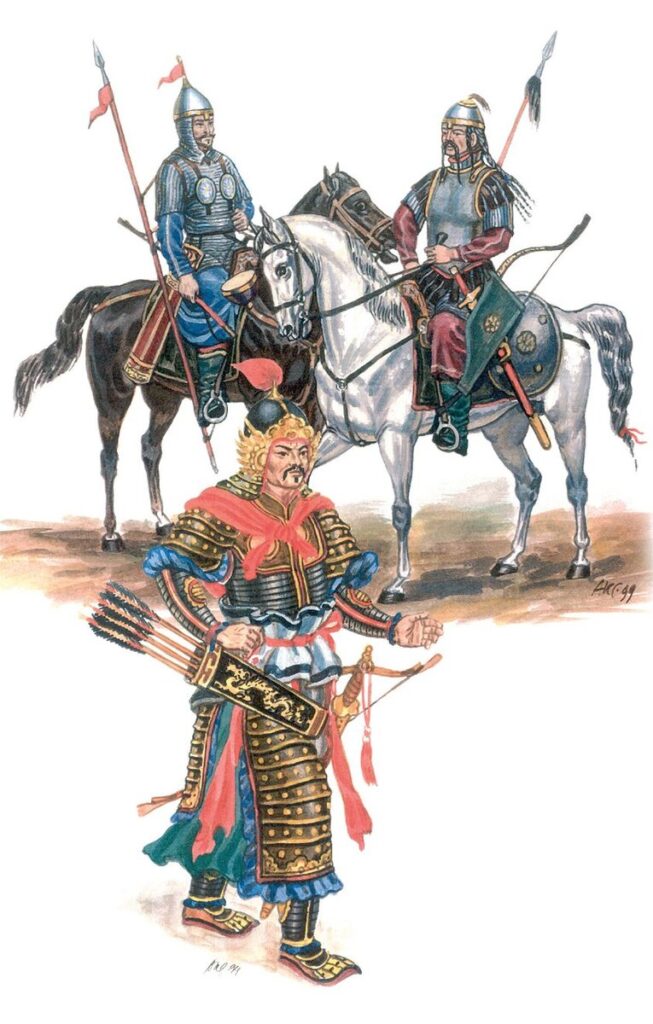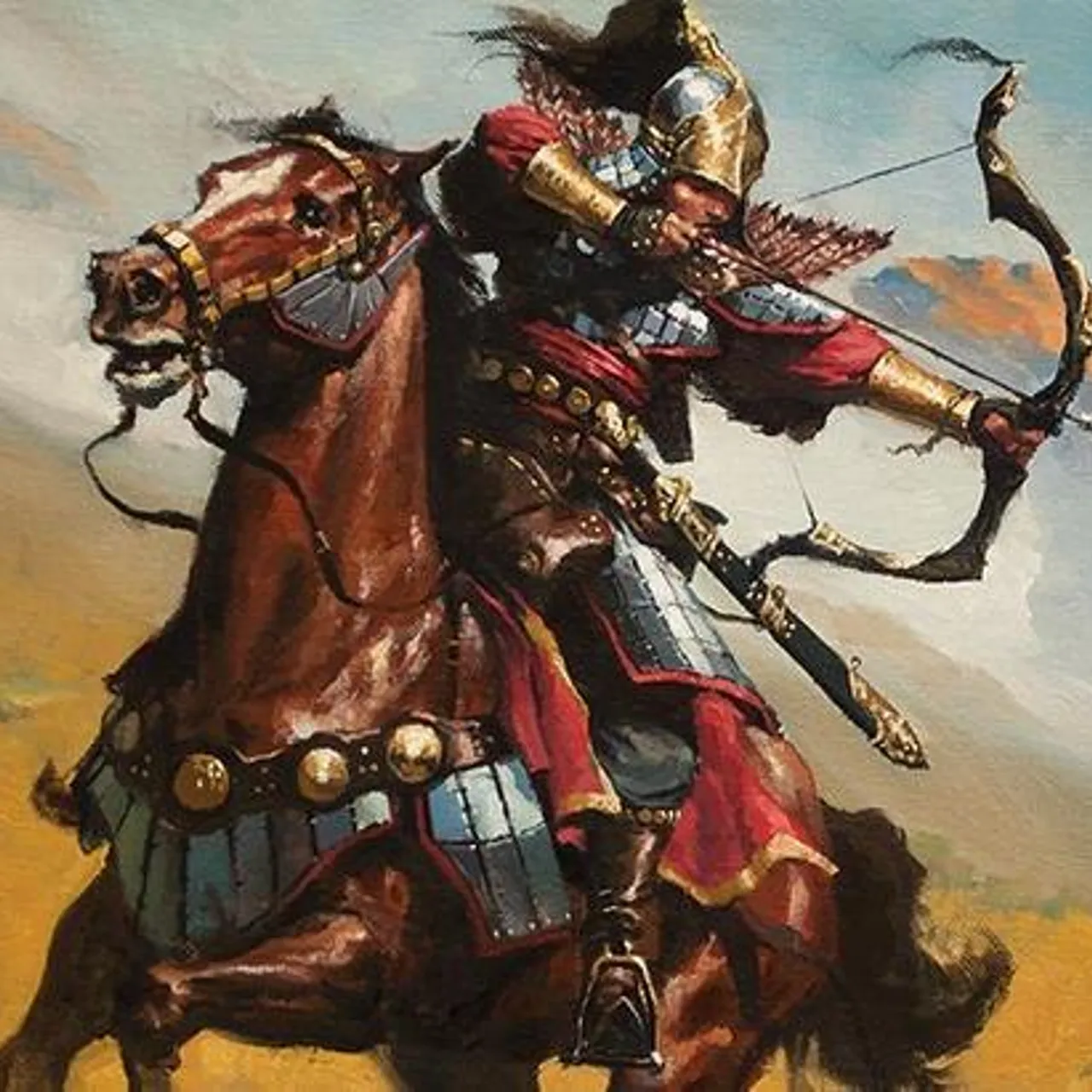Despite the fact that Emperor Sui-Wen-di managed to disunite the Turks, and his son Yang di successfully continued this business, they had nothing to rejoice about. The internal system of the empire was in an extremely deplorable state. The population, groaning under a heavy tax burden, was ready to join at least the Turkic Khaganate, if only not to be under the rule of the Sui dynasty.

The Sui Empire (Chinese: 隋, pinyin Suí) was a Chinese state that existed in 581-618 and united the country after a long period of turmoil. She has implemented a number of socio-economic reforms and major construction projects.
At that time, the Western Turkic Khaganate was strengthening in the west of the Turkic possessions. After the death of the third ruler of the Western Turks, Nili Khan, in civil strife, the infant kagan Taman Khan ascended to the throne.
He was supported not by Turkic vigilantes, but by simple nomads from different tribes under the rule of the Turks, who were extremely interested in peace on their land. They were mainly representatives of the Dulu tribal union, which had strengthened under Taman Khan.
The Dulu made the kagan their puppet and decentalized his power by appointing two of his governors, who actually became independent rulers. In addition, they appointed a special dignitary who, instead of the kagan, conducted sacred rituals of worship to the spirits of the ancestors. After that, the Dulu began to actively attack caravans traveling along the Great Silk Road, which caused trade stagnation. Stagnation led to the loss of income for Sogdians and Turks.

Outlaw
Therefore, they colluded with the Nushibi tribal union, which has long been engaged in the wiring and protection of caravans.
The grandson of the second khagan of the Western Turks, Kara-Churin-Turki — Shegui Khan, stood at the head of the opposition. At that time, he ruled the shire in Chacha (modern Tashkent).
In 612, the Nushibi defeated Dulu and Taman Khan fled to China, where he was cunningly killed.
Shegui Khan led a fairly successful policy of uniting all the tribes from the Altai to the Volga and was able to annex even the rebellious Russian state on Ishim and the belligerent Bulgarians in the Volga region. And most importantly, he restored international trade along the Great Silk Road.

Turkic warriors
And in the eastern Turkic lands, the Chinese were in charge at that time. Their puppet Zhangar Khan carried out any instruction of the Chinese emperor.
But in 608, Zhangar died and his son, Shibir Khan, was appointed in his place.
At the same time, the Chinese Emperor Yang Di conducted an extremely unsuccessful domestic and foreign policy:
Emperor Yang ruled from 604 to 617 and completed major engineering projects, in particular the construction of the Great Canal by the hands of 2 million workers. He contributed to the reconstruction of the Great Wall of China, which claimed the lives of 6 million people. During his reign, 8 million Chinese were employed in the construction of imperial palaces, roads, siege equipment and ships — Wikipedia
The monarch tried to expand the borders of his empire, but he did it unsuccessfully. The conquest of the South Vietnamese state of Champa in 605 failed due to the loss of the army, which was destroyed by malaria, and three unsuccessful campaigns against the Korean state of Goguryeo in 612-614, repelled by General Yilchi Mundok, depleted the Chinese treasury and caused the death of 3 million Chinese soldiers — Wikipedia

Sui Yang-di, or Emperor Yang (Chinese: 569 — March 11, 618) was the second emperor of the Chinese Sui Dynasty, the second son of Emperor Wen. Years of government: 604-617. In historical literature, however, the name Sui Yang-di (隋炀帝) is more often used — the Sui Emperor Yang.
After such failures, the population of Northern China, who carried large tax and military duties, rebelled against Yang Di. They were supported by the Turks, led by Shibir Khan.
Yang di took refuge in one of the fortresses on the Great Wall of China, and then moved south to the Jiang Du fortress (near Nanjing) and was soon killed by one of his generals. The empire began to fall apart.
Shibir Khan and his Turks became the master of the Chinese lands.
A civil war began in China, which lasted seven years. Finally, the warlord Li Yuan, who led the detachments of the well-known Xianbians, won it.

Gao-tzu (April 8, 566 — June 25, 635), birth name — Li Yuan (李淵) — Chinese emperor (618-626), founder of the Tang Dynasty. The motto of the board is Ude. A major feudal lord from Shanxi Province. Taking advantage of the weakening of the Sui Dynasty’s power as a result of numerous peasant uprisings and feudal feuds, in 617 he captured the capital Chang’an, where he was declared emperor in 618. He led wars with his son Li Shimin for the subjugation of the whole country. Defeated all other rivals, including Li Gi, Dou Jiande, Wang Shikong, Xue Rengao and Liu Wuzhou. In an effort to stop peasant uprisings, he announced a reduction in the tax burden. Li Shimin was removed from power — Wikipedia
In 619, the powerful Shibir Khan died. His successor was Chulo Khan, who had to engage in battles with the insurgent Chinese and Uighurs. The Turkic men-at-arms relocated to the west, which gave Li Shimin the opportunity to gather his strength.
The Eastern Turks waged a fierce struggle against the rebellious Uighurs, who were united by the Jaglakar clan, who nominated Shygian Sygin to the khans. His headquarters were on the Selenga River. He was succeeded in power by the son of Yaosha Pusa.
In 620, Chulo Khan died of illness and Kat Il Khan Bahadur Shat ascended the throne, who raised Tatabs, Khitans and Togonians against the Uighurs. The Kagan began to assemble a large army, hoping to put an end to the Uighurs once and for all.
But the preparations were stopped due to the outbreak of war with the Chinese commander Li Shimin, who usurped power in the Tang Empire. The Turks invaded China and plundered the northern provinces until 624.
In 624, a truce was concluded and it was a mistake of the Turks, as it allowed Li Shimin to assemble 8 cavalry corps, strengthen the defenses on the border and create a river fleet on the Yellow River.
Therefore, during the renewed hostilities during the campaign of 625-626, the Turks were no longer able to take fortresses, and several of their detachments were defeated. Peace was concluded and the Turks, having received gold and silk, retreated.
The collapse of the Eastern Turkic Khaganate was coming

Tai Zong, birth name — Li Shimin (January 23, 599 — July 10, 649) was a Chinese emperor (from 627) of the Tang Dynasty.
In 627, the Seyanto tribes (ancestors of the Kipchaks) joined the rebellious Uighurs. The winter that year was snowy and cattle fell because of jute, undermining the strength of the eastern Turks.
In 628, Yaoshi Pusa defeated the Turks in the battle of Mount Mazongshan.
Tolos-shad, who led the Turks in this battle (the ruler of the extreme eastern aimag of the khaganate), was beaten with sticks for the lost battle. Returning to his native land, Tolos-shad raised the Khitan subordinates against the khagan Kat Il Khan. The Khitan were supported by Li Shimin, who moved his cavalry corps to help them.
In 629, the Chinese drove the Turks from their ancestral homeland, the Ordos.
This caused the collapse of the khaganate. The Turkic beks began to swear allegiance to Li Shimin en masse. Kat Il Khan went beyond the Gobi, and lost his influence among the Turks. In 630, he was captured by the Chinese and imprisoned in Chang’an, where he died in 634 from longing for the steppe.
The Eastern Turkic khaganate has fallen!

Chang’an, translated as «the long world», is a now—defunct city in China, the ancient capital of several Chinese states. It was the destination of trade caravans that traveled along the Great Silk Road to China. Today, the city of Xi’an is located on the site of Chang’an.
And at this time, the Western Turkic khaganate under Tun-Jabgu Khan became a powerful empire. He was supported by the Nushibis and Sogdians, and the military force was made up of forced Dulu. However, in 630 they rebelled and killed Tun Jabga Khan
But the Nushibi, with Chinese support, were able to defeat the rebels and restore order. But as a result of civil strife, lands in Khorasan and the Caucasus were lost, and the Bulgarians, having separated from the Western Turks, founded their own state headed by Kubrat Khan.
